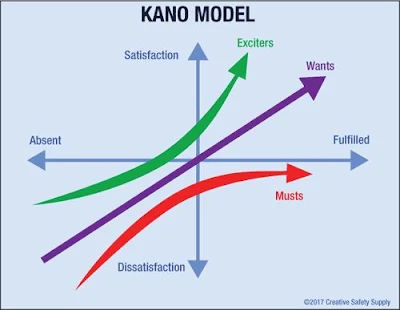🏭 Quality Tools in Manufacturing: Six Sigma, Kano Model & Juran’s Trilogy
In the competitive world of manufacturing, quality is everything. From reducing defects on the assembly line to understanding customer expectations and maintaining consistent performance—every improvement matters. Three powerful quality concepts often used in manufacturing are Six Sigma, the Kano Model, and Juran’s Trilogy. In this blog, we will explore how each of these concepts drives excellence in the manufacturing industry.
🔍 Six Sigma in Manufacturing
Six Sigma is a process improvement methodology focused on reducing variation and eliminating defects in manufacturing processes. The goal is to achieve near-perfect quality—just 3.4 defects per million opportunities.
📌 Core Concept: DMAIC Framework
Six Sigma uses the DMAIC framework:
1. Define → Identify problem & goals (e.g., High rejection rate in CNC machining) 2. Measure → Collect data on current process performance 3. Analyze → Use root cause analysis (Fishbone, 5 Whys) to find defect causes 4. Improve → Implement solutions (e.g., retooling, machine calibration) 5. Control → Standardize and monitor to sustain improvement
🏭 Example in Manufacturing:
A car manufacturer uses Six Sigma to reduce defects in the door panel fitting line. After applying DMAIC, they reduce defects from 400 ppm to just 5 ppm by tightening welding parameters and retraining operators.
📊 Kano Model in Manufacturing
The Kano Model helps manufacturers understand how different product features affect customer satisfaction. It is especially useful during product design or improvement.
📌 Kano Categories:
1. Basic Needs → Expected features (e.g., functional brakes in a vehicle) 2. Performance Needs → Better quality brings more satisfaction (e.g., fuel efficiency) 3. Excitement Needs → Surprise features (e.g., auto-park assist) 4. Indifferent → Features that don’t matter to customers 5. Reverse → Features that annoy customers (e.g., overly complex dashboard)
🏭 Example in Manufacturing:
When designing a new washing machine, a company uses Kano analysis to classify customer feedback. They discover that “quiet operation” is a performance need, while “auto detergent refill” is an excitement need. This insight helps prioritize design features.
📘 Juran’s Trilogy in Manufacturing
Dr. Joseph M. Juran introduced the Juran Trilogy, which outlines three managerial processes essential for achieving high quality in manufacturing.
📌 Juran Trilogy Components:
1. Quality Planning → Design processes that meet customer needs 2. Quality Control → Monitor operations to keep processes stable 3. Quality Improvement → Identify areas with gaps & improve systematically
🏭 Example in Manufacturing:
A furniture manufacturer implements Juran’s Trilogy:
- Planning: Develops specifications for a new ergonomic chair.
- Control: Monitors assembly lines with quality control charts.
- Improvement: Identifies that seat cushion failure is frequent—root cause analysis leads to a switch to a better foam supplier.
🧩 Flow of Juran’s Trilogy:
Start → Plan Product & Process → Control Daily Operations → Spot Issues → Launch Improvement Projects → Achieve Better Quality → Control Again
📌 Summary Table: Comparison in Manufacturing
| Concept | Purpose | Manufacturing Use |
|---|---|---|
| Six Sigma | Reduce defects through data and process control | Reduce variation, improve consistency (e.g., process yield) |
| Kano Model | Understand customer priorities and satisfaction | Feature prioritization during product design |
| Juran’s Trilogy | Plan, control, and improve quality | Manage end-to-end quality initiatives and metrics |
📥 Final Thoughts
Combining Six Sigma, the Kano Model, and Juran’s Trilogy allows manufacturers to:
- 📉 Minimize waste and rework
- 😊 Deliver what customers truly value
- 📈 Continuously improve production and product quality
Mastering these concepts provides manufacturers with a framework for excellence, adaptability, and customer satisfaction in the modern industrial era.






0 Comments